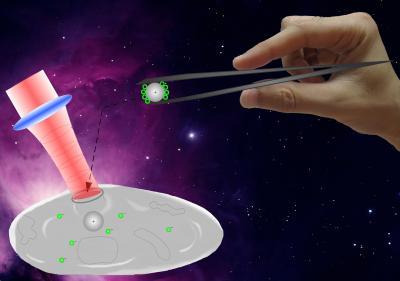WASHINGTON, Aug. 7—The applications of gene therapy and genetic engineering are broad: everything from pet fish that glow red to increased crop yields worldwide to cures for many of the diseases that plague humankind. But realizing them always starts with solving the same basic scientific question—how to "transfect" a cell by inserting foreign DNA into it. Many methods already exist for doing this, but they tend to be clumsy and destructive, not allowing researchers to precisely control how and when they insert the DNA or requiring them to burn through large numbers of cells before they can get it into one.
A team of scientists in South Korea have now developed the most precise method ever used to insert DNA into cells. The method combines two high-tech laboratory techniques and allows the researchers to precisely poke holes on the surface of a single cell with a high-powered "femtosecond" laser and then gently tug a piece of DNA through it using "optical tweezers," which draw on the electromagnetic field of another laser. The team's approach, which is a breakthrough in precision and control at the single-cell level, was published today in the Optical Society's (OSA) open-access journal Biomedical Optics Express.
"What is magical is that all this happens for one cell," said Yong-Gu Lee, an associate professor in the School of Mechatronics at the Gwangju Institute of Science and Technology in South Korea and one of the researchers who carried out the study. "Until today, gene transfection has been performed on a large quantity of agglomerate cells and the outcome has been observed as a statistical average and no observations have been made on individual cells."

a) A laser scanning microscope image of a cancer cell used in the experiment is shown. The green circles show plasmid-coated particles that have been optically tweezed and inserted into the cell. b) The same cell viewed with a fluorescence microscope is shown. The DNA material inserted into the cell through the transfection process carries a gene that codes for a green fluorescent protein. Here, the cell's green glow means the transfection process was successful. c) Image (b) is superimposed on image (a).
(Photo Credit: Biomedical Optics Express.)
Common techniques to force DNA into cells can be clumsy or even violent, Lee said. For instance, researchers often use so-called "gene guns" to fire particles coated with strands of DNA known as plasmids at large populations of cells. Alternatively, scientists may puncture the membranes of individual cells with lasers, place the cells in a plasmid soup, and let the genes diffuse into the perforated cells on their own. While either method can transfect some fraction of a population, researchers cannot control whether any individual cell will incorporate the desired genes, and large numbers of cells may be damaged or destroyed in the process.
In the new study, the researchers sought to safely transfect an individual cell. To manipulate the foreign DNA, the scientists used optical tweezers, which essentially tweaks a laser beam whose electromagnetic field can grab hold of and transport a plasmid-coated particle. The researchers first moved the particle to the surface of the cell membrane. Guided by the trapped particle, they then created a tiny pore in the cell membrane using an ultra-short laser pulse from a femtosecond laser. While another laser beam detected the exact location of the cell membrane, they pushed the particle through the pore with the tweezers. Using this technique, the scientists were able to ease a microparticle right up to the pore in the membrane and drop it into the cell, like a golfer sinking an easy putt.
To determine whether their method had succeeded, the researchers inserted plasmids carrying a gene that codes for a green fluorescent protein. Once inside the cell, the gene became active and the cell's machinery began producing the protein. The researchers could then detect the green glow using a fluorescence microscope. They found that approximately one in six of the cells they studied became transfected. This rate is lower than that recorded for some other methods, but those are less precise and involve many cells at a time.
Lee hopes the work will allow other researchers to investigate the effects of transfection on individual cells, not just large populations. With the new technique, "you can put one gene into one cell, another gene into another cell, and none into a third," he said. "So you can study exactly how it works."

Image 2: Optical manipulation of plasmid-coated particles and insertion into the cell through a small pore punctured by a short-pulsed laser is shown. Plasmids produce a green fluorescent protein once inside the cell. Drawing is not to scale.
(Photo Credit: Gwangju Institute of Science and Technology)
Source: The Optical Society